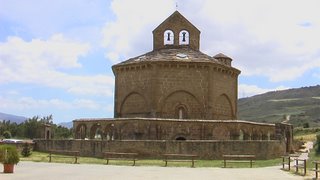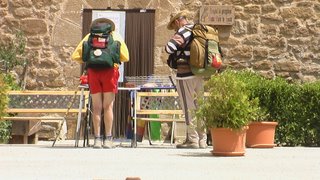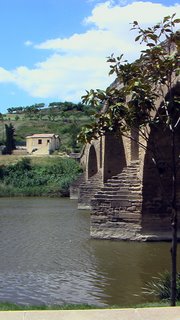 the way there, we had other things to see. First on Karen's list was a tiny Templar church outside of Eunate. It was fairly close: a small (garage-sized) octagonal church, with nothing more than a tabernacle (occupied) and a statue of Mary, seated and holding Jesus. Here we encountered our first "Camino" pilgrims, lean, brown, silent. Three groups of two (one group on bikes) pilgrims each, heading for Santiago, on the other side of Spain. A long stone building near the church had a sign marking it as a family home (no souvenirs or postcards!), but it was obvious also that the family hosts pilgrims for the night.
the way there, we had other things to see. First on Karen's list was a tiny Templar church outside of Eunate. It was fairly close: a small (garage-sized) octagonal church, with nothing more than a tabernacle (occupied) and a statue of Mary, seated and holding Jesus. Here we encountered our first "Camino" pilgrims, lean, brown, silent. Three groups of two (one group on bikes) pilgrims each, heading for Santiago, on the other side of Spain. A long stone building near the church had a sign marking it as a family home (no souvenirs or postcards!), but it was obvious also that the family hosts pilgrims for the night. 
Leaving the town, we passed another group of pilgrims, and there were still more on a side street. We pasted the "Puente de la Reina" and saw pilgrims crossing on foot and on bike. I was feeling sheepish about our being in a car, until we passed two tour buses. Puente de Reina is a lovely, picturesque town. The Camino de Santiago passes right through it, and we paused here for about an hour. Somewhere in that hour, I lost Karen again. This time, it was not to a shop, but to the Roman bridge. She must have dozens of shots of it. In Puente de Reina we stopped in two tiny churches, also visited by the pilgrims. The church of the Crucifix is almost entirely bare and empty, except for its striking cross. Here, too, everything had been  destroyed and (partially) restored. I also got a picture of several St. James statues; each church has at least one! (I was thinking of my Dad and of the several "Jameses" among my nephews--and my future brother-in-law.)
destroyed and (partially) restored. I also got a picture of several St. James statues; each church has at least one! (I was thinking of my Dad and of the several "Jameses" among my nephews--and my future brother-in-law.)
 destroyed and (partially) restored. I also got a picture of several St. James statues; each church has at least one! (I was thinking of my Dad and of the several "Jameses" among my nephews--and my future brother-in-law.)
destroyed and (partially) restored. I also got a picture of several St. James statues; each church has at least one! (I was thinking of my Dad and of the several "Jameses" among my nephews--and my future brother-in-law.)As we drove away, toward the Pais Vasco, the terrain changed. There were mountains of rock, but with thick stands of pine and here and there a swath of Roman aqueduct. Highway signs became bi-lingual: Spanish and Euskera (Basque). We found ourselves going off the highway and onto a winding single lane road in a forest, stuck behind a construction vehicle. We passed a town with a short, almost stubby stone church, heavy and solid, in a Romanesque style, and then back into the woods, with intermittent fields of moss-covered rock and grass and severely pruned trees. On a winding road, needless to say, between forest and pastures. Our destination was an extremely remote 5th century church dedicated to St. Michael and perched on a cold and very windy mountainside. Actually, the tiny 5th century church is inside a larger, 12th century church. We found the Blessed Sacrament even here. There was also, oddly enough, an "Osteria." I wondered how they could make a living up at the top of a cliff, but it seems that many tourists and pilgrims do make the ascent, as we had. There also seemed to be a large hostel that was not in operation. I took pictures and video footage of the quaint church(es), but few of the photos came out. (Par for the course!)
The drive allowed us to see several kinds of Spanish landscapes. Navarre was green, green, green, with pine trees on the hills all pointing up like the tips of feathers. The trees had been planted in stands, each kind of tree creating a different patch of texture on the hills, making them look like a piece of monochrome crewel, or a knitted work with different stitches. Tunnels took us in and out of the rocky hills. In the farming areas, we started seeing haystacks that looked like giant mushrooms. After a while, the squared-off buildings of stone, with red clay tile roofs and balconies edged in brick become normal. There were long-haired goats on a hillside, and on another slope, at the side of the road, I saw an old man with a scythe. The scattered towns had small industries, while just outside of them, there were pastures on the steep hills, and terraced farms, and tiny buildings like Monopoly houses.
Even with GPS (with a female voice!), our driver, Pedro Maria, was having trouble finding the small towns that we want to visit. Spaniards don't travel much outside of their own cities, and Azpeitia, it turns out, is in the middle of absolutely nowhere. Pamplona, on the other hand, is a real city, with an airport and everything. (Perhaps that is because the French won in St. Ignatius' crucial battle there.) But Pedro had the amazing ability to stop and ask for directions. More than once. A few more curving roads--and some near misses with speeding trucks that even made the driver cringe and hug the edge of the pavement--and we were in the Loiola valley, the town of Azpeitia, birthplace of Ignatius Loyola.

2 comments:
It sounds like you had a wonderful trip...I am a divinity student at a Jesuit institution looking for some friendly blog conversations. I enjoyed your avid descriptions and the enthusiasm with which you told your story. I hope you don't mind me dropping by every once in a while to ay hello. Peace.
You forgot the part where we were almost killed by the big truck. (Not to be confused by the part where we were almost killed by the big bus.) Poor Pedro Maris, I barely remember him. Except he kept making calls on the cell phone, and I had a feeling he was calling someone to say "I'm driving two insane women across Spain."
Post a Comment